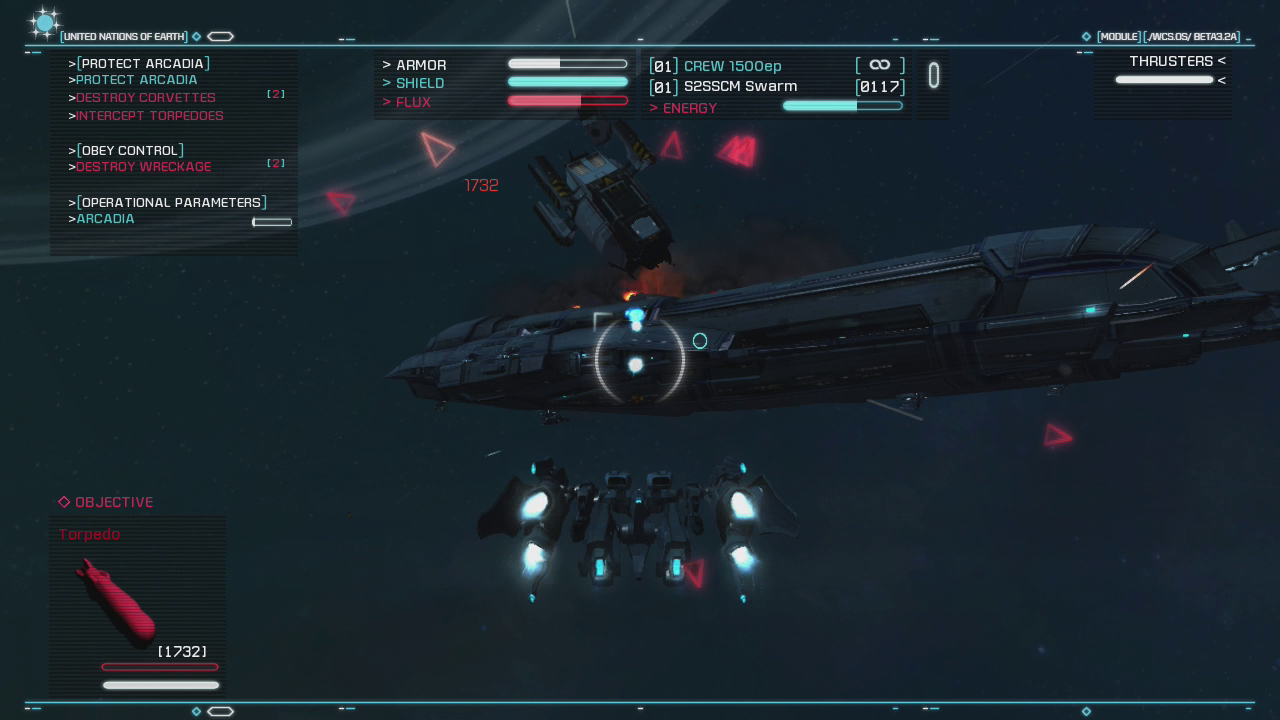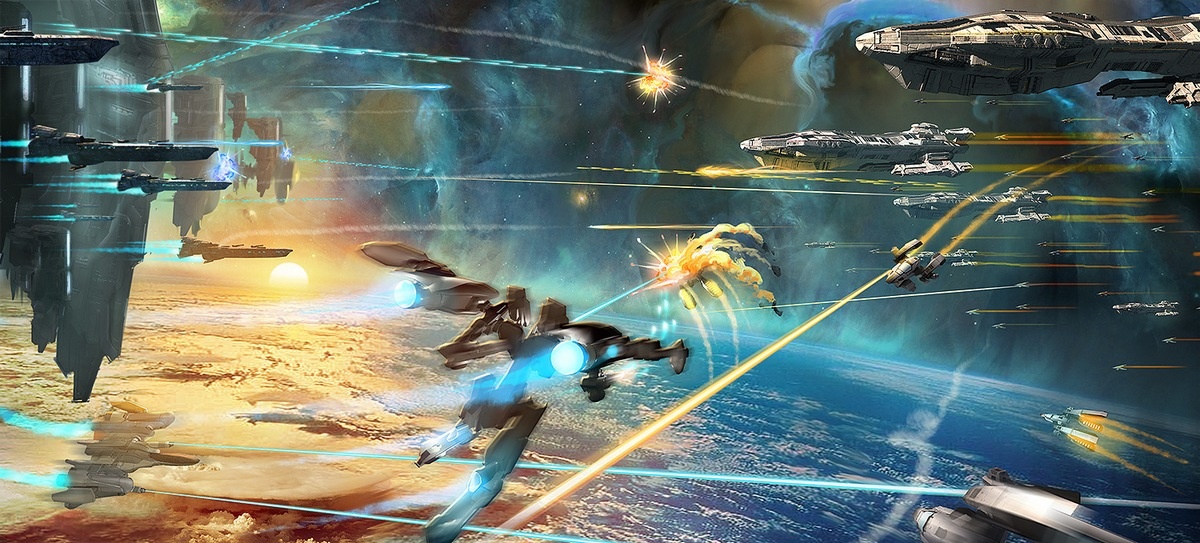Earth's future hangs by a thread. After decades of expansion and colonization across the universe, man's disparate factions are fighting for independence from their homeworld. Strike Suit Zero puts you in the role of Adams, a faceless soldier, as you defend the United Nations of Earth from the Colonial onslaught. Though a few nagging issues persist throughout, Strike Suit Zero's strengths continuously rise to the surface, and whether it's the dramatic renderings of outer space or the heady mix of grace and aggression during battle, there's simply a lot to love about its modern twist on the decidedly stale space combat genre
Before acquiring the game's namesake war machine, you have to complete a few introductory tutorials in a standard fighter jet to get acclimated to the controls. Jets are fast, and your test fighter is no exception. You can engage thrusters for an additional boost of speed to keep up with fleeing enemies, but topping out can also send you slightly off course due to the effects of inertia. Unlike the strike suit you command during much of the campaign, jets have the ability to disable incoming missiles by emitting an electromagnetic pulse. The EMPs get the job done, but the lack of something like a quick barrel-roll feels like a missed opportunity for practical showmanship. The standard fighter is quite simple in that regard. After a few minutes, you'll have no problem mowing down enemy ships while jetting across the battlefield, and Adams will be cleared for his return to active duty.
Each of the four ships used throughout the campaign are capable of equipping various types of guns and missiles simultaneously. Most scenarios are flexible enough that you can develop your own loadout without jeopardizing your chances of success, since that responsibility ultimately falls onto your ability to strike or flee at key moments. Missiles that lock onto enemy aircraft have a finite supply of ammo, so it’s smarter to utilize standard machine guns or plasma rounds rather than auto-targeting every enemy from the start. Once you deplete your cache of ammo within individual missions, you’re out of luck since there are no items or supplies to be found in the vastness of space.
However, rather than lean on the notion that space is a mostly empty void, each stage is replete with fantastic images of gigantic celestial bodies and gaseous nebulae that make the entire experience a joy to behold. Debris and casualties of war decorate the foreground while jetstreams of red and blue dance across the screen. The balance of scale and visual flourishes make you feel like a part of the action, rather than a mere observer of distant wonders.

The relatively dull jet gameplay at the start leaves a lackluster first impression, but once the game puts you in the seat of the Strike Suit, it spreads its wings and never looks back.
From the handful of ships you’ll pilot during the course of the game, the Strike Suit remains the most enjoyable to use for it's ability to transform and out maneuver enemy aircraft. Once you’ve gathered the right amount of flux energy from shooting down enemies and space debris, your suit can change into a nimble mech with considerably stronger firepower and the ability to quickly dash out of harms way. Every shot you fire in strike mode depletes your flux meter, so finding the balance between your two states becomes a critical skill for success in later missions. The advantages the mech brings to the table include the ability to auto-lock onto the nearest target and the potential to train missiles on up to five enemies at once, but be careful: you can still get shot down if you neglect to watch your back. Once you get a taste of juggling the nimble jet and the powerful mech, it’s hard to go back to the less exciting alternatives. It’s too bad that you can’t use it in every mission, but thankfully there are only a few where it’s unavailable.
Strike Suit Zero's campaign takes roughly 10 hours to complete your first time through, but there are plenty of incentives for replaying each mission, including powerful ship upgrades and alternate endings. Every mission has secondary objectives that can be completed to unlock new armor or weaponry and these tasks typically include protecting or destroying a particular ship during battle. Having to do so while also working on primary objectives feels like an impossible task at times and the considerable length of most missions ends up being the biggest roadblock to success. However, when you finally manage to overcome the odds, the pay off of stronger armor and a faster ship makes future attempts at completing optional objectives a less formidable affair; a reward in and of itself.
As fun as the combat missions are overall, they’re generally too long for their own good. With combat and action as fast paced as it is, it’s frustrating when a few seconds worth of mistakes wipes out nearly an hour of progress. The infrequency of checkpoints is a big demotivator when failure is so easy to stumble into. When you do fail a mission, it's usually due to a mistake on your part, but there's a chance it's connected to unexplainable spikes in difficulty.
The story is secondary to the excitement of combat, but it’s more interesting than it initially lets on. Conversations rarely pertain to anything other than new objectives and strategic analysis, and there’s virtually zero character development, but once the veil is lifted and a certain pivotal character reveals their endgame, these revelations retroactively benefit the events leading up to that point. There are many instances of borrowed inspiration from fairly well known sources, but the finale lends Strike Suit Zero an identity all its own.

If you have the privilege of owning three monitors and an SLI or Crossfire setup, it's highly recommended that you play with multiple-monitor support enabled. The vastness of space is the perfect fit for such an arrangement, but there's essentially no HUD to be found in the first-person view. It seems like an odd omission given the potential for intricate and immersive renderings of the cockpit, as proven in games like Steel Battalion and Hawken. It's also jarring when the camera switches to the third-person view when entering strike mode, but considering the uninspired view from Adams' perspective, you rarely feel compelled to look through his eyes anyway.
If you’ve got the itch for an adrenaline infused shooter in the vein of Wing Commander or Star Wars: X-Wing vs. TIE Fighter, Strike Suit Zero won't disappoint. While they're occasionally frustrating, the lengthy missions and missed opportunities fade into the background at the end of the day. It's one of the most thrilling, inventive, and fascinating space combat sims in recent memory, and its thirteen white-knuckled missions are definitely worth seeing through to the end, even if they occasionally over stay their welcome.